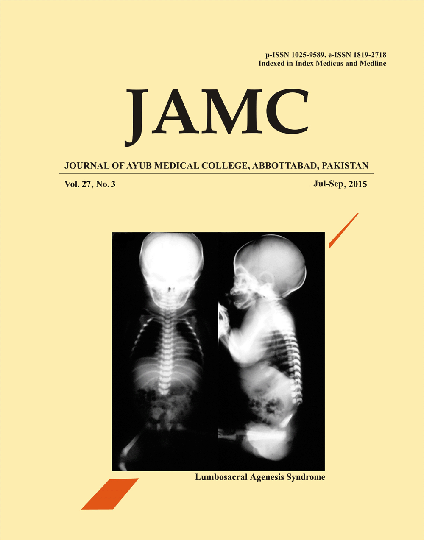CORELATION OF ADVERSE PERINATAL OUT COMES AND PLACENTAL INFARCTS IN HYPERTENSIVE PRETERM PREGNANCIES
Abstract
Background: The placenta can provides valuable information about the damaging effects of hypertension on pregnancy and foetal outcome. This study was conducted to study the frequency of placental infarcts in hypertensive preterm pregnancies and its effects on foetal outcomes. Methods: This cross-sectional study was conducted at Department of Obstetrics and Gynaecology, Khyber Teaching Hospital, Peshawar and Department of Anatomy, Khyber Medical College, Peshawar from January 2008 to March 2009. The sample size consisted of hundred placentae divided into two groups. Group A consisting of 50 normal full term placentae (delivered between 37-42 weeks of gestation). Group-B consisting of 50 premature placentae from hypertensive mothers (35-37 weeks of gestation). The data was collected on a pre-designed Performa and analysis was done by SPSS-17. Results: In the placentae of premature group the incidence of placental infarcts were increased. Foetal outcome was poor in the presence of placental infarcts. Conclusion: Adverse perinatal outcomes including growth restriction and still birth is higher in hypertensive premature deliveries with placental infarcts than in normal full term deliveries.References
Dekker GA, Kraayenbrink AA. Oxygen free radicals in preeclampsia. Am J Obstet Gynecol 1991;164:273-5.
Demir- Wiensten, Seval Y, Kaufmann P, Demir R, Yucel G, Huppertz B. Matrix metalloproteinases 2,3 and 9 in human term placenta. Acta Histochem 2007;109(5):403-12.
Dutta DK, Dutta B. Study of human placentae associated with preeclampsia and essential hypertension in relation to foetal outcome. J Obstet Gynecol India 1989;39(6):757-63.
Driscoll SG. Placental Examination in Clinical Setting. Arch Pathol Lab Med 1991;115(7):668-71.
Emmrich P, MalzerP. Morphology of placenta in postmaturity. Pathol Microbiol (Basel) 1968;32(5):285-302.
Faye-Peterson, OM. The placenta in preterm birth. J Clin Pathol 2008;61(12):1261-75.
Goldenberg RL, Faye-Petersen O, Andrews WW, Goepfert AR, Cliver SP, Hauth JC. The Alabama Preterm Birth Study: diffuse decidual leukocytoclastic necrosis of the decidua basalis, a placental lesion associated with preeclampsia, indicated preterm birth and decreased fetal growth. J Matern Fetal Neonatal Med 2007;20(5):391-5.
Fox H. Senescence of placental villi. J Obstet Gynecol Br Commonw 1967;74(6):881-5.
Kiran N, Zubair A, Khalid H, Zafar A. Morphometrical analysis of intervillous space and villous membrane thickness in maternal anaemia. J Ayub Med Coll Abbottabad. 2014;26(2):207-11.
Sherin F, Afzal E, Seema N. Gross morphological changes in premature and post mature human placentae. J Ayub Med Coll Abbottabad 2015;27(2):448-50.
Fox H. Aging of placenta. Archives of Disease In Childhood, 1997;77:165-70.
Placental morphology in hypertensive disorders of pregnancy and its correlation with fetal outcome. J Obstet and Gynecol India;46(1):40-6.
Downloads
Published
How to Cite
Issue
Section
License
Journal of Ayub Medical College, Abbottabad is an OPEN ACCESS JOURNAL which means that all content is FREELY available without charge to all users whether registered with the journal or not. The work published by J Ayub Med Coll Abbottabad is licensed and distributed under the creative commons License CC BY ND Attribution-NoDerivs. Material printed in this journal is OPEN to access, and are FREE for use in academic and research work with proper citation. J Ayub Med Coll Abbottabad accepts only original material for publication with the understanding that except for abstracts, no part of the data has been published or will be submitted for publication elsewhere before appearing in J Ayub Med Coll Abbottabad. The Editorial Board of J Ayub Med Coll Abbottabad makes every effort to ensure the accuracy and authenticity of material printed in J Ayub Med Coll Abbottabad. However, conclusions and statements expressed are views of the authors and do not reflect the opinion/policy of J Ayub Med Coll Abbottabad or the Editorial Board.
USERS are allowed to read, download, copy, distribute, print, search, or link to the full texts of the articles, or use them for any other lawful purpose, without asking prior permission from the publisher or the author. This is in accordance with the BOAI definition of open access.
AUTHORS retain the rights of free downloading/unlimited e-print of full text and sharing/disseminating the article without any restriction, by any means including twitter, scholarly collaboration networks such as ResearchGate, Academia.eu, and social media sites such as Twitter, LinkedIn, Google Scholar and any other professional or academic networking site.










